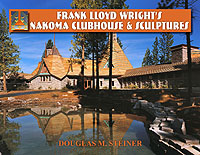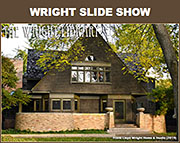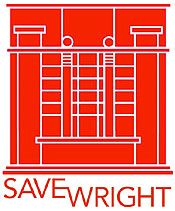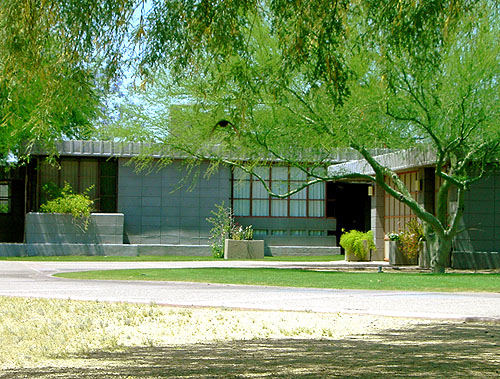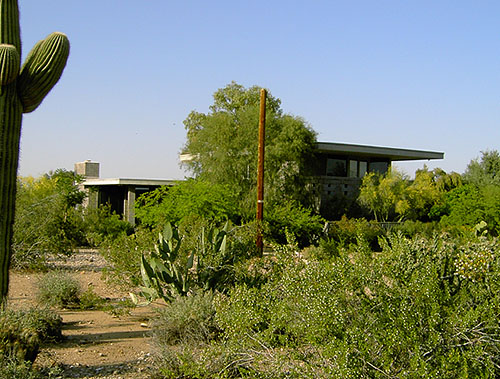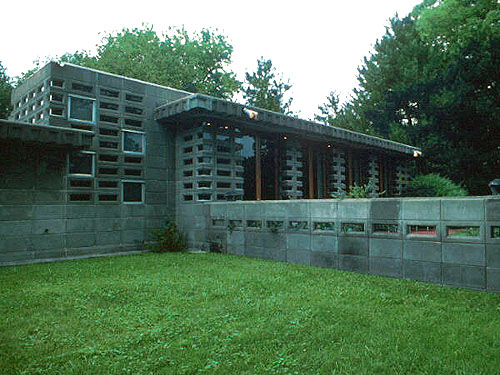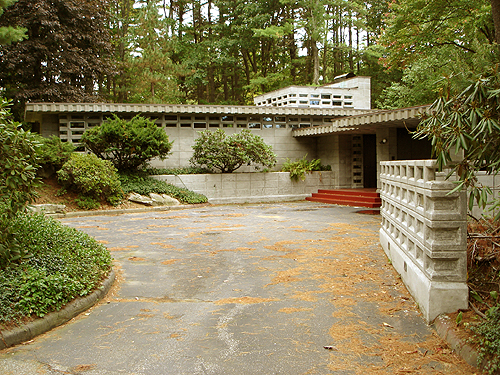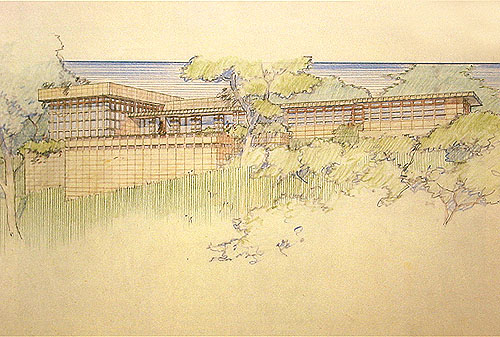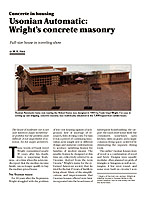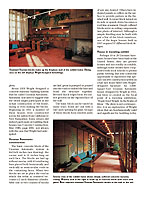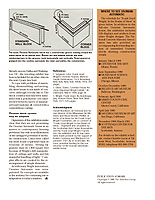|
|
-
Wright Studies
Usonian Automatic Homes |
|
|
In 1936, Wright
developed a series of homes he called Usonian. They were
designed to control costs. Wright's Usonian houses had no
attics, no basements, and little ornamentation. He continued
to develop the concept, and in the early 1950s he first used
the term Usonian Automatic to describe a Usonian style house
made of inexpensive concrete blocks. The modular blocks
could be assembled in a variety of ways. Wright hoped that
home buyers could save money by building their own Usonian
Automatic houses. But assembling the modular parts proved
complicated, and most hired contractors to built their
Usonian houses. A precursor to the Usonian Automatic
system were the four Textile Block homes in California,
Millard (La Miniatura) S.214, Storer S.215, Freeman S.216,
and the Ennis S.217.
The basic concrete block of the Usonian
Automatic system is 12 x 24 inches. The blocks were laid
without mortar, with rebar placed both horizontally and
vertically in semicircular joints. After one or two rows of
blocks were laid, cement grout was pumped or poured into the
joints to bond the structure together. There were many homes
designed (projects), but only seven Usonian Automatic homes
were built using concrete molded blocks. The concept was
designed on a two foot grid floor plan. The walls were built
with 1' x 2' blocks and the ceiling blocks were 2' x 2'.
Others Usonian homes were built, but constructed of standard
concrete blocks and other material. May 2009. |
| |
Bock Ateliers
Pre-Usonian
Usonian Concrete
Block House (1934)
Usonian Automatic Homes
Completed Usonian Automatic Homes
Usonian Automatic Unbuilt Projects
In The Realm of Ideas 1988-1991
Concrete Construction Magazine
New York Times
Related Items
Seattle P-I
Related Reading |
|
|
|
|
| |
| |
|
|
|
|
| |
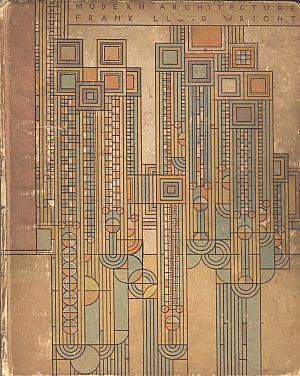 "Modern Architecture, Being the Kahn Lectures for
1930", Wright, 1931.
Of interest is the illustration that
proceeds Chapter 5. The illustration is entitled "Bock Ateliers.
Concrete. Slab Roof. Stone Washes and Water Table. Windows
Wrapping Corners to Express Interior Space. 1902." Bock met
Wright in 1892 while working for Adler & Sullivan. Bock’s first
commission from Wright was for the Frieze on the third floor of
the Heller Home (1896 - S.038). He also worked on other Wright
projects including the
Stork (1898) and
Boulder
(1898) for Wright’s own Studio, the
Dana Residence
(1902 - S.072),
Larkin Building (1903 - S.093),
Scoville Park
Fountain (1903 - S.094),
Unity
Temple (1904 - S.096),
Martin (1904 - S.100),
City National Bank
(1909 - S.155), and
Midway Gardens (1913 - S.180) just to name a few. In 1902 Wright to design a
home and studio for Bock. It was designed in
concrete. This was two years before the concrete Unity Temple,
twenty-one years before Wright’s first concrete block home, the
Millard Residence (1923 - S.214), and 49 years before the first
Usonian Automatic,
the Adelman Residence (1951 - S.344). Wright included the
concrete "Bock Ateliers" in his 1910
Wasmuth Portfolio Plate LXII. Although the 1902 window
casements were most likely designed in wood, Wright slightly
modified the 1931 window design to include mitered glass
corners, a precursor to Wright’s 1951 Usonian Automatic Homes. "Modern Architecture, Being the Kahn Lectures for
1930", Wright, 1931.
Of interest is the illustration that
proceeds Chapter 5. The illustration is entitled "Bock Ateliers.
Concrete. Slab Roof. Stone Washes and Water Table. Windows
Wrapping Corners to Express Interior Space. 1902." Bock met
Wright in 1892 while working for Adler & Sullivan. Bock’s first
commission from Wright was for the Frieze on the third floor of
the Heller Home (1896 - S.038). He also worked on other Wright
projects including the
Stork (1898) and
Boulder
(1898) for Wright’s own Studio, the
Dana Residence
(1902 - S.072),
Larkin Building (1903 - S.093),
Scoville Park
Fountain (1903 - S.094),
Unity
Temple (1904 - S.096),
Martin (1904 - S.100),
City National Bank
(1909 - S.155), and
Midway Gardens (1913 - S.180) just to name a few. In 1902 Wright to design a
home and studio for Bock. It was designed in
concrete. This was two years before the concrete Unity Temple,
twenty-one years before Wright’s first concrete block home, the
Millard Residence (1923 - S.214), and 49 years before the first
Usonian Automatic,
the Adelman Residence (1951 - S.344). Wright included the
concrete "Bock Ateliers" in his 1910
Wasmuth Portfolio Plate LXII. Although the 1902 window
casements were most likely designed in wood, Wright slightly
modified the 1931 window design to include mitered glass
corners, a precursor to Wright’s 1951 Usonian Automatic Homes. |
| |
|
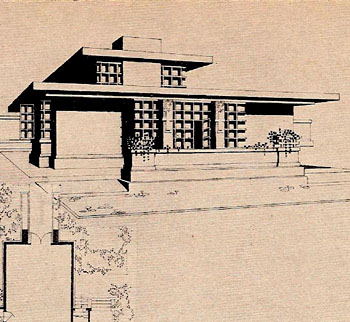 |
|
Detail of "Bock Ateliers" 1931 Modern Architecture. |
| |
|
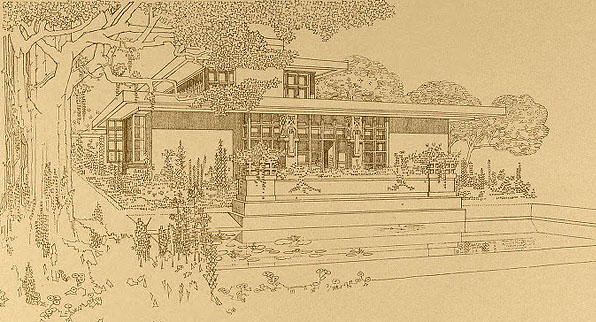 |
| Detail of "Bock
Ateliers" 1910 Wasmuth Portfolio Plate LXII. |
| |
|
|
|
|
|
|
|
|
|
|
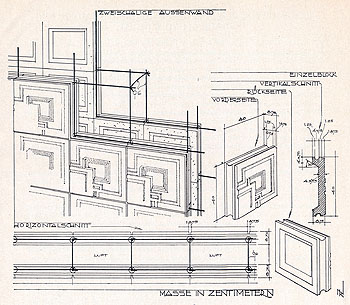 |
Date:
1926
Title:
Charles Ennis Residence, Los Angeles, CA,
Illustration 1926 (1923 - S.217).
Description:
Diagram of
the cement block construction for the Ennis House. Illustration
published in
Frank Lloyd
Wright: Aus dem Lebenswerke eines Architekten, De Fries,
1926, p.63. Caption: "Darstellung der Zementblockbauweise des
Architekten Frank Lloyd Wright. Masse in zentimetern."
(Representation of the cement block construction by the
architect Frank Lloyd Wright. Dimensions in centimeters.) In
1921 Frank Lloyd Wright prepared a "Study for Block House in
Textile Block Construction,"
Frank Lloyd Wright
Monograph 1914 - 1923, Pfeiffer, 1990, p.204-205.
According to Sweeney, Wright attempted to obtain a patent for
the system in 1921,
Wright
in Hollywood, 1994, p.43-44. A blueprint was prepared of
this drawing in German for De Fries, and is published in
Frank Lloyd Wright
Monograph 1914 - 1923, Pfeiffer, 1990, p.242. The
blueprint is also published in
Wright 1917-1942, Pfeiffer, 2010, p.90. This
concept was used for
Usonian Automatic Homes.
Size:
Copy 9.25 x 8 B&W photograph.
S#:
0172.55.0721 |
|
|
|
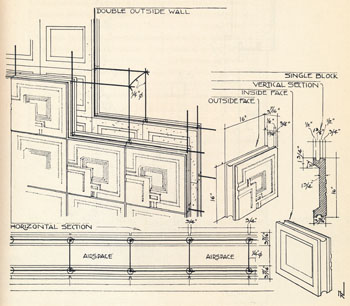 |
Date:
1926/1954
Title:
Charles Ennis
Residence, Los Angeles, CA, Illustration 1954 (1923 - S.217).
Description:
Diagram of the
cement block construction for the Ennis House. Illustration
published in
The Natural House,
Wright, 1954, p.203. This illustration was first published in
German in
Frank Lloyd Wright: Aus dem
Lebenswerke eines Architekten, De Fries, 1926, p.63. Caption:
"Representation of the cement block construction by the
architect Frank Lloyd Wright." In 1921 Frank Lloyd Wright
prepared a "Study for Block House in Textile Block
Construction," Frank
Lloyd Wright Monograph 1914 - 1923., Pfeiffer, 1990, p.204-205.
According to Sweeney, Wright attempted to obtain a patent for
the system in 1921, Wright in Hollywood,
1994, p.43-44. A blueprint was prepared of this drawing in
German for De Fries, and is published in Frank
Lloyd Wright Monograph 1914 - 1923., Pfeiffer, 1990, p.242. The
blueprint is also published in
Wright 1917-1942, Pfeiffer, 2010, p.90.
Size:
Copy 9.25 x 8 B&W
photograph.
S#:
0992.10.0721 |
|
|
|
|
|
|
|
|
|
|
|
|
|
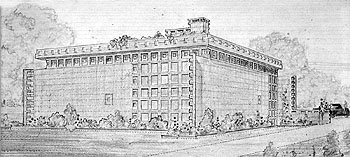 |
Date:
1934
Title:
Broadacre City, Usonian Concrete Block
House, Perspective, Circa 1934.
Description:
Perspective view of the Usonian Concrete Block House designed by
Frank Lloyd Wright. Published in The Living City,
Wright, 1958, p.70. Text on sleeve: "Wright, F. L. - Broadacre City
- Usonian House . 3-1. Usonian Concrete Block House Project.
Render., Perspective drawing. 1924-29. Broadacre City Project.
Wright, Frank Lloyd. U of Virginia FAIC." Acquired from the archives
of the University of Virginia.
Size:
35mm Color slide, sandwiched between glass, plastic mount.
S#:
0376.07.0420 |
|
|
|
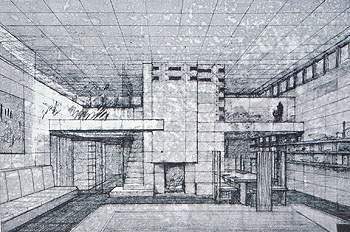 |
Date:
1934
Title:
Broadacre City, Usonian Concrete Block
House, Living Room Perspective, Circa 1934.
Description:
Perspective view of the Usonian Concrete Block House Living Room
designed by Frank Lloyd Wright. Published in The Living City,
Wright, 1958, p.70. Text on sleeve: "Wright, F. L. - Broadacre City
- Usonian House . 3-2. Usonian Concrete Block House Project.
Render., Interior Living Room perspective drawing. 1924-29.
Broadacre City Project. Wright, Frank Lloyd. U of Virginia FAIC."
Acquired from the archives of the University of Virginia.
Size:
35mm Color slide, sandwiched between glass, plastic mount.
S#:
0376.08.0420 |
|
|
|
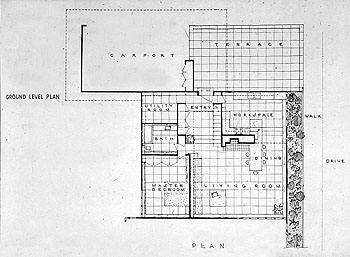 |
Date:
1934
Title:
Broadacre City, Usonian Concrete Block
House, Ground Plan, Circa 1934.
Description: Ground
Plan for the Usonian Concrete Block House designed by Frank Lloyd
Wright. Published in The Living City,
Wright, 1958, p.71. Text on sleeve: "Wright, F. L. - Broadacre City
- Usonian House . 1-1. Usonian Concrete Block House Project. Plan
Ground Floor. 1924-29. Broadacre City Project. Wright, Frank Lloyd.
U of Virginia FAIC." Acquired from the archives of the University of
Virginia.
Size:
35mm Color slide, sandwiched between glass, plastic mount.
S#:
0376.09.0420 |
|
|
|
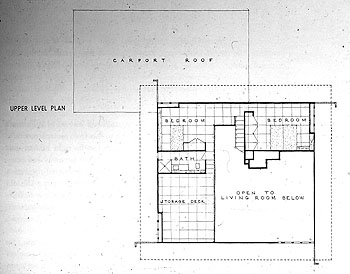 |
Date:
1934
Title:
Broadacre City, Usonian Concrete Block
House, Upper Level Plan, Circa 1934.
Description: Upper
Level Plan for the Usonian Concrete Block House designed by Frank
Lloyd Wright. Published in The Living City,
Wright, 1958, p.71. Text on sleeve: "Wright, F. L. - Broadacre City
- Usonian House . 1-1. Usonian Concrete Block House Project. Plan
Upper Level. 1924-29. Broadacre City Project. Wright, Frank Lloyd. U
of Virginia FAIC." Acquired from the archives of the University of
Virginia.
Size:
35mm Color slide, sandwiched between glass, plastic mount.
S#:
0376.10.0420 |
|
|
|
|
|
|
|
|
|
|
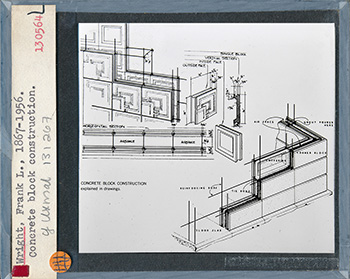
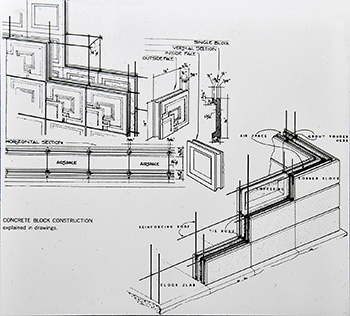 |
Date:
1926/1954
Title:
Vintage 4" x 3.25" Magic Lantern Slide of
Concrete Block Construction 1926 / 1954.
Description:
Copy photograph of
a combination to two illustrations. The top left is an
illustration of the construction of the Charles Ennis Residence,
Los Angeles, CA, Illustration (1923 - S.217). It was published
in German in
Frank Lloyd Wright: Aus dem
Lebenswerke eines Architekten, De Fries,
1926, p.63. It was published in English in The Natural House,
Wright, 1954, p.203.
The
lower right is the Usonian Automatic
House Construction (S#0992.11) Illustration, 1954. Diagram
of the concrete block construction for the Usonian Automatic
House. Illustration was published in
The Natural House,
Wright, 1954, p.201.
Magic lantern slides were used in the U.S. during the late 1800s
through the first half of the 1900s. Text: “Sectional View of
the Dining Room. Sectional View of the Living Room. Sectional
View of Entry.”
Text on
face of slide: “Wright, Frank L., 1867-1956 (sic).concrete block
construction. 130564. Art Dept Smith College.” Acquired from the
Art Department at Smith College.
Size:
Magic lantern slide
4" x 3.25", Transparency: 3" x 2.6"
S#:
0172.61.0725
Left: Detail of Magic Lantern Slide Above. |
|
|
|
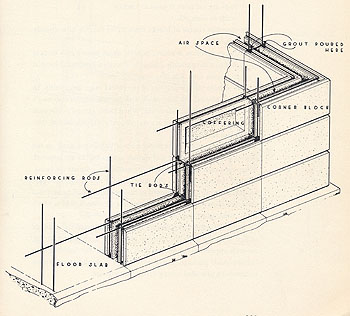 |
Date:
1954
Title:
Usonian Automatic House Construction
Illustration 1954.
Description:
Diagram of the concrete block construction
for the Usonian Automatic House. Illustration published in
The Natural House,
Wright, 1954, p.201. In 1921 Frank Lloyd Wright prepared a "Study
for Block House in Textile Block Construction," Frank
Lloyd Wright Monograph 1914 - 1923., Pfeiffer, 1990, p.204-205.
According to Sweeney, Wright attempted to obtain a patent for the
system in 1921, Wright in Hollywood,
1994, p.43-44. In 1923, Frank Lloyd Wright designed four textile
block homes in Los Angeles. 1) Millard (La Miniatura) (1923 -
S.214); 2) Storer (1923 - S.215); 3) Freeman (1923 - S.216); 4)
Ennis (1923 - S.217). Circa 1934, Wright designed a Usonian Concrete
Block House for Broadacre City. In 1936, Wright developed a series
of homes he called Usonian. They were designed to control costs.
Wright's Usonian houses had no attics, no basements, and little
ornamentation. He continued to develop the concept, and in the early
1950s he first used the term Usonian Automatic to describe a Usonian
style house made of inexpensive concrete blocks. The modular blocks
could be assembled in a variety of ways. Wright hoped that home
buyers could save money by building their own Usonian Automatic
houses. But assembling the modular parts proved complicated, and
most hired contractors to built their Usonian houses. A precursor to
the Usonian Automatic system were the four Textile Block homes in
California. The basic concrete block of the Usonian Automatic system
is 12 x 24 inches. The blocks were laid without mortar, with rebar
placed both horizontally and vertically in semicircular joints.
After one or two rows of blocks were laid, cement grout was pumped
or poured into the joints to bond the structure together.
Size:
8.75 x 8 B&W copy photograph.
S#:
0992.11.0721 |
|
|
|
|
|
|
|
|
Completed
Usonian Automatic Homes |
|
|
|
|
| |
|
Tracy (1955 - S.389) |
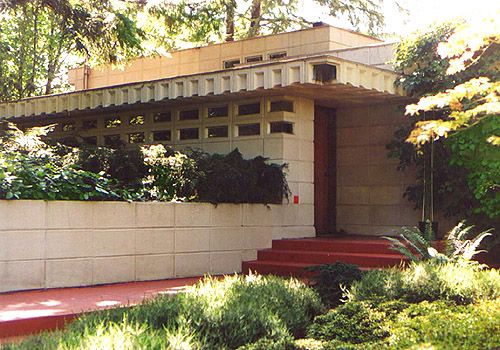 |
|
Copyright
Douglas M. Steiner, 2001.
(Tracy Study) |
|
|
| |
|
Pappas (1955 - S.392) |
 |
|
Courtesy of
ocad123 Flickr,
2002. |
| |
|
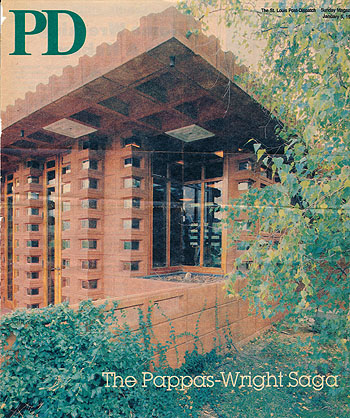 |
Date:
1986
Title:
St. Louis Post-Dispatch - January 5, 1986 (Published by the
St. Louis Post-Dispatch, St. Louis) (Article only)
Author:
Porter, E.F. Jr.; Photos: Holt, Robert C. Jr.
Description:
"The Saga of Ted & Bette Pappas & Frank Lloyd Wright. If you
are rich and famous – or even merely rich – a designer house
is like a designer garment: you can enjoy the satisfaction
of ownership without the agonies of creation and upkeep, and
you can get out of it whenever you feel like it. But suppose
you're like Theodore and Betty Pappas, by their own account
just ordinary folk: struggling and hard-working when they
were young, and now, in their late-middle years, comfortable
but not wealthy West County empty-nesters, with four grown
children and several grandchildren... Supposed to most
extraordinary thing about you is a steely resolve to live in
a house designed for you by the world’s most famous
architect. Suppose that house must serve, not just as part
of a collection of pied-a-terra (Condos in the Caribbean,
A-frames in Aspen), but home..." Includes 6 photographs.
Size:
10 x 11.5
Pages:
Pp Cover, 5-10
ST#:
1986.92.0717 |
|
|
|
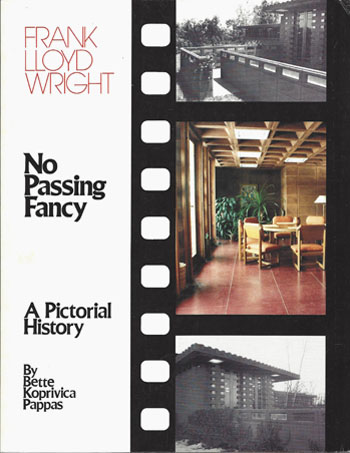 |
Date:
1995
Title:
Frank Lloyd Wright: No Passing Fancy. A Pictorial History
(Soft Cover) (Published by Betty K. Pppas, St. Louis,
Missouri)
Author: Pappas, Bette Koprivica
Description:
Theodore and Bette Pappas Residence.
Preface: For the last thirty years people have asked my
husband and me how we came to choose Frank Lloyd Wright as
our architect. Did we get to meet him personally? Was he
very expensive? What was it like living in a home designed
by him? Once, a woman came up to us at a dinner party, after
learning Mr. Wright had designed a home for us, and asked is
she could touch us. During our twenty years of occupancy,
from 1964 to 1984, we have given guided tours and first-hand
information to students and faculty members from community
colleges, Washington University, University of Missouri-St.
Louis, and Southern Illinois University at Edwardsville.
Unfortunately, we weren’t able to accommodate all requests
for tours and information. Still unanswered is a small stack
of letters and questionnaires requesting in formation on how
we view the house - for instance, do we view the wall as a
wall, windows, or screens, etc. Since detailed
questionnaires like these are so time-consuming, we couldn’t
answer them individually... (Second edition)
(See Pappas furniture.)
Size:
8.5 x 11
Pages: Pp 57
ST#:
1995.89.0517 |
| |
|
| |
|
| |
|
|
|
Usonian Automatic Unbuilt Projects |
|
|
|
In The Realm of Ideas: Usonian Automatic Traveling
Exhibit - 1988-1991 |
|
|
|
From January 1988 through March
1991, "Frank Lloyd Wright:
In The Realm of Ideas" a traveling exhibition included
a full-scale Usonian Automatic model. The design that was
chosen for the full-scale model was the
Sussman Residence (project). The full-scale home used
lightweight construction material replicating concrete. This
enabled quick dismantling, transporting and re-erection of
the model. The tour exhibited in
eight cities. Dallas (Jan-Apr 1988), Washington DC
(June-Sept 1988), Miami (Dec-Feb 1989), Chicago (Jun-Sept
1989), Bellevue, WA (Oct-Jan 1990), San Rafael, CA (Feb-May
1990), San Diego (Jun-Sept 1990) and Scottsdale (Dec-Mar
1991). |
| |
| Dallas
(January - April 1988) |
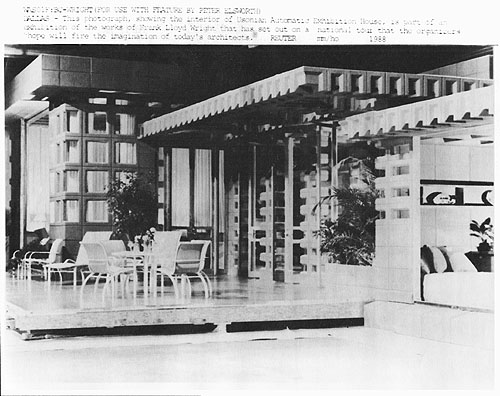 |
|
Usonian Automatic
Traveling Exhibit House. Dallas (January-April, 1988). Caption on face:
"Dallas – This photograph, showing the interior of Usonian Automatic
Exhibition House, is part of an exhibition of the works of Frank Lloyd Wright
that has set out on a national tour that the organizers hope will fire the
imagination of today’s architects. Reuter. 1988." Stamped on verso: "Feb 12
88". The full size Usonian Automatic model home was exhibited in eight
cities. Dallas (Jan-Apr 1988), Washington DC (June-Sept
1988), Miami (Dec-Feb 1989), Chicago (Jun-Sept 1989),
Bellevue, WA (Oct-Jan 1990), San Rafael, CA (Feb-May 1990),
San Diego (Jun-Sept 1990) and Scottsdale (Dec-Mar 1991).
Acquired from the archived of the Chicago Tribune. See more information on
the Usonian
Automatic Traveling Exhibition. |
| |
| Dallas
(January - April 1988) |
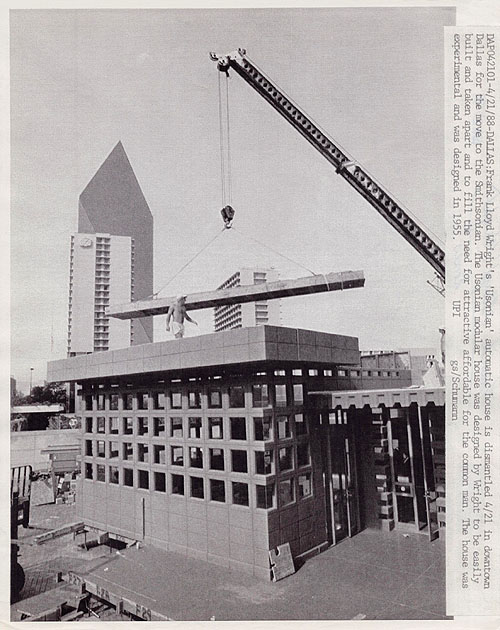 |
|
Usonian Automatic
Traveling Exhibit House. Dallas (January-April, 1988). Caption on face:
"Dallas – Frank Lloyd Wright’s ‘Usonian’ automatic house is
dismantled 4/21 in downtown Dallas for the move to the
Smithsonian. The Usonian modular
house was designed by Wright to be easily built and taken apart and to fill
the need for attractive affordable for the common man. The house was
experimental and was designed in 1955. UPI." Stamped on verso: "Apr 25 88".
The full size Usonian Automatic model home was exhibited in eight cities.
Dallas (Jan-Apr 1988), Washington DC (June-Sept 1988), Miami
(Dec-Feb 1989), Chicago (Jun-Sept 1989), Bellevue, WA
(Oct-Jan 1990), San Rafael, CA (Feb-May 1990), San Diego
(Jun-Sept 1990) and Scottsdale (Dec-Mar 1991). Acquired from
the archived of the Chicago Tribune. See more information on
the Usonian
Automatic Traveling Exhibition. |
| |
| Chicago
(June - September 1989) |
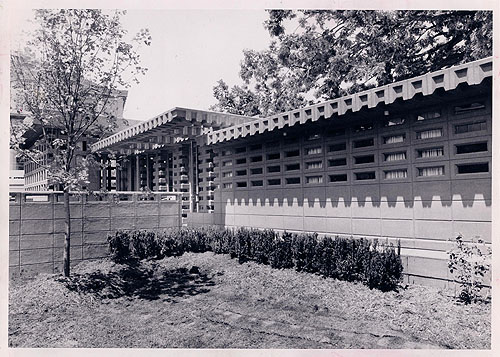 |
|
Usonian Automatic Traveling Exhibit
House. Chicago. The
Chicago Exhibit was held from June - September 1989 at the Museum of Science
and Industry. See more information on
the Usonian
Automatic Traveling Exhibition. |
| |
| Bellevue,
WA (October - January 1990) |
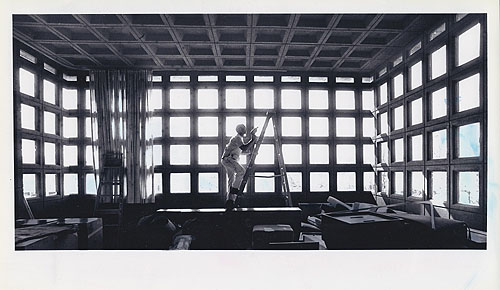 |
|
Usonian Automatic Traveling Exhibit
House. Seattle. The
Seattle Exhibit was held from October - January 1990 at the
Bellevue Art Museum. See more information on
the Usonian
Automatic Traveling Exhibition. |
| |
| San
Rafael, CA (February - May 1990) |
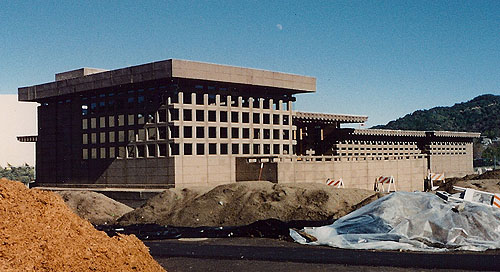 |
|
Marin County Civic Center,
San Rafael, CA
(Feb-May 1990), Copyright
SDR Design 1990. |
| |
| Floor Plan |
 |
| Floor plan
for the Usonian Automatic Traveling Exhibit and the Sussman
Residence. |
| |
| Side View |
 |
| Side view
for the Usonian Automatic Traveling Exhibit and the Sussman
Residence. |
| |
| |
|
| |
|
|
Concrete Construction Magazine |
| |
Usonian Automatic:
Wright's Concrete Masonry
Copyright The Aberdeen Group, 1988
Published in Copcrete Construction Magazine, November 1, 1988
By Mary K. Hurd |
|
Abstract:
About 1950, Frank Lloyd Wright designed
a concrete masonry building system that he called Usonian Automatic.
Automatic was used to suggest that the owner might participate in
the actual construction of the home, laying or even making the
blocks. Beginning in 1951 a number of these houses were constructed
across the nation from California to New Hampshire. The basic
concrete block of the Usonian Automatic system is 4x12x24 inches.
The blocks are laid up without mortar, with #3 reinforcing bars
placed both horizontally and vertically in semicircular voids in the
contacting faces. After one or two courses of blocks are laid, grout
is pumped or poured into the voids to embed the bars and bond the
structure together. |
|
|
|
Click to see full PDF article. |
| |
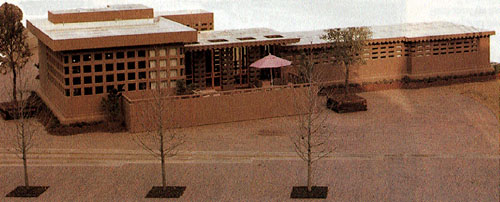 |
|
Usonian Automatic
home now touring the United States was designed in 1955 by Frank
Lloyd Wright. For ease in setting up and shipping, concrete masonry
was realistically simulated in the 1,800-square-foot exhibit house.
Copyright The Aberdeen Group, 1988. |
| |
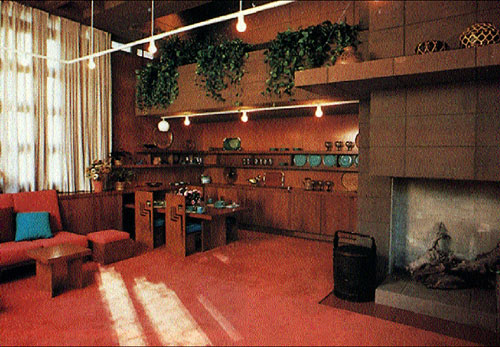 |
|
Standard Usonian
blocks make up the fireplace wall of the exhibit home. Dining area
on the left displays Wright-designed furnishings. Copyright The Aberdeen Group, 1988. |
| |
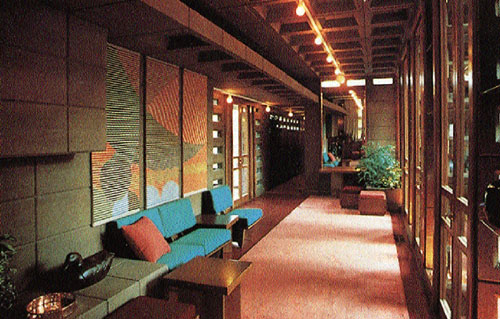 |
|
Interior view of
the exhibit home shows deeply coffered concrete masonry ceiling.
Window wall at the right is made up of concrete block units inset
with glass. Note exposed standard Usonian Automatic blocks in the
wall at the left. Copyright The Aberdeen Group, 1988. |
| |
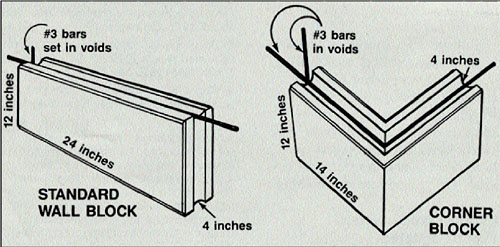 |
| The basic Usonian
Automatic block has a semicircular groove running around the entire
block on its narrow face. Blocks are laid without mortar, but with
reinforcing bars in the grooves, both horizontally and vertically.
Grout poured or pumped into the cavities surrounds the rebar and
unifies the construction.
Copyright The Aberdeen Group, 1988. |
|
| |
| |
| |
|
|
New York
Times |
| |
(Note, due to the fact that the
internet is constantly changing, and items that
are posted change, I have copied excerpts of the text, but give all the
credits available.) |
| |
|
Wright Seen Anew as an Architect of Thoughts
By Paul Goldberger
The New York Times, February 7, 1988
http://www.nytimes.com/1988/02/07/arts/architecture-view-wright-seen-anew-as-an-architect-of-thoughts.html?sec=&spon=&pagewanted=1
In the 28 years since Frank Lloyd Wright's death,
his associates, who have tried to keep the flame of his reputation
burning, have often done more to damage his name than to enhance it.
Under the rubric of Taliesin Associated Architects (named for the
architect's famous houses in Spring Green, Wis., and Scottsdale,
Ariz.) they have produced new buildings that are generally mediocre
imitations of the great architect's late work. Through their Frank
Lloyd Wright Foundation, they have continued Wright's practice of
inviting students to pay for the privilege of studying with the
master, even though there is no longer a master. And they have sold
off various original Wright drawings to keep their operation going.
It has all too often
felt like a cult more than a living enterprise. Given all of this,
expectations had not been particularly high for the latest project
the Wright disciples have undertaken, a major exhibition intended to
travel the country and serve as an introduction to Wright's ideas.
Focusing on ''ideas'' more than actual buildings seemed as if it
would, if anything, encourage the tendency to view Wright in
quasi-religious, instead of realistic, terms: Wright the deity, not
Wright the architect.
But the pleasant
surprise of the large and striking exhibition ''Frank Lloyd Wright
in the Realm of Ideas'' that opened last month at the Dallas Museum
of Art and the adjoining Trammell Crow Center Pavilion, is that it
holds deification to a minimum. This is hardly a critical
exhibition; those interested in a dissenting view on Frank Lloyd
Wright must look elsewhere. But it is perhaps the most inviting and
articulate introduction to Wright's basic ideas that anyone has
offered the public in many years. The exhibition is lively and
handsome; it includes a wide range of models, original furniture
pieces, blown-up reproductions of Wright drawings and spectacular
color photographs enlarged to mural size. The climax is a full-scale
version of one of Wright's Usonian houses that has been erected on
the grounds of the Dallas Museum of Art, with the unlikely
background of the city's downtown office towers.
Let there be no mistake:
this is not the major retrospective of Wright that has been awaited
for many years, and neither is it an exhibition that will advance
the frontiers of Wright scholarship. It is a layman's show, not a
scholar's. But it presents Wright in a manner that is clear and
straightforward, and that should do much to excite the public's
interest in the man who was unquestionably America's greatest
architect of this century. And it does so without pandering to the
public or grossly oversimplifying Wright's ideas.
The exhibition, which
was organized by the Frank Lloyd Wright Foundation in cooperation
with the Scottsdale Arts Center Association and underwritten by the
Whirlpool Corporation and the Kohler Company, has been organized in
an unusual way. It is not chronological, or arranged by building
type. Rather, the curators, Gerald Nordland, an art historian, and
Bruce Brooks Pfeiffer, the chief archivist at the Frank Lloyd Wright
Foundation, have classified the material into four thematic
sections: ''The Destruction of the Box,'' ''The Nature of the
Site,'' ''Materials and Methods'' and ''Building for Democracy,''
echoing themes that were central to Wright's own concerns, and that
the architect returned to again and again in his own writings. It is
Wright himself who speaks throughout this exhibition: the pleasing
thing is that the curators have been discreet, and have placed
themselves in the background. Only Wright's own words are used as
the wall text for the exhibition; in every way is this show Wright
on Wright. This is vastly more convincing than being presented with
testaments to Wright from his disciples. For the architect himself,
though he tended toward wild exaggeration and on occasion simplified
or revised facts to suit his own ends, had a glorious rhetorical
flourish. It is actually rather ironic, given how desperately
Wright's followers have tried over the years to maintain his
reputation, that they have done it best by doing the simplest thing
- putting themselves in the background and letting Wright in effect
present himself to us.
The thematic organization means that some important
Wright buildings, such as Fallingwater, the great house of 1937 in
Mill Run, Pa., or the Johnson Wax Company headquarters in Racine,
Wis., also of 1937, pop up again and again in the exhibition. But
this only helps to underscore the continuity of these themes
throughout the architect's career, and the fact that his important
work transcended narrow categorization within a single theme. The
spectacular cantilevered structure of Fallingwater, for example, was
as critical an example of Wright's desire to create forms that
opened up the traditional box as it was indicative of his ability to
respond subtly and powerfully to the particular nature of a dramatic
site.
These first two themes -
breaking out of the box and working with nature - actually work best
in this format, since they are the easiest to explain. It is not
hard to trace Wright's struggle to break out of the box from his
early Prairie houses with their flowing horizontal space to such
late works as the great spiral rotunda of the Guggenheim Museum. (An
early model of the Guggenheim forms the centerpiece of this
section.) And it is pleasing, even moving, to be taken through these
buildings with Wright's own words as our only text, telling us, as
in the words placed beside a picture of his great Unity Temple of
1906, that ''there perhaps is where you will find the first real
expression of the idea that the space within the building is the
reality of the building. . .When I finished Unity Temple, I had it.
I knew I had the beginning of a great thing, of a great truth in
architecture.''
So, too, with the
section on the relationship of buildings to nature: these short
snatches of Wright's words, flush with hyperbole though they be,
become an almost endearing accompaniment to dramatic photographs.
''A house, we like to believe, can be a noble consort to man and the
trees'' is the beginning of the text panel before a picture of the
Pew House, in Shorewood Hills, Wis., a structure of wood set within
a lush landscape. But the other sections are less convincing.
''Materials and Methods'' calls for more rigorous analysis than it
gets here, and is something of a catchall for numerous interesting
projects, such as Wright's unbuilt skyscraper for The San Francisco
Call of 1912, that did not fit elsewhere. As for ''Building for
Democracy,'' this was always the vaguest and most overblown sphere
of Wright's rhetoric, and it is still vague here, even though this
section does have its share of excellent illustrative material and
the same splendid verbal accompaniment of the other sections.
And that brings us to
the real crowd-pleaser in this exhibition, the Usonian Automatic
House. Wright called many of his smaller houses, intended to bring
architecture to the masses, Usonian; this particular one was
designed in 1955, and was to have been built in concrete block,
called ''automatic'' because Wright wanted the building system to be
simple enough to avoid the cost of skilled labor. (This version has
been built in synthetic material to simulate the appearance of
concrete block to make assembly, dismantling and moving easier.) If
you can get over your surprise at the presence of a microwave and
other post-Frank Lloyd Wright appliances that were obviously the
price of Whirlpool and Kohler's sponsorship, a walk through the
house is a marvelous moment. It is not large - just 1,800 square
feet - but Wright's ability to control and manipulate space and
light was so remarkable that the house feels significantly bigger.
The ceiling plane begins at 9 1/2 feet at the entrance, goes down to
7 1/2 feet in the bedrooms, and leaps up to 12 1/2 feet in the
living room, and there is real spatial drama to this movement.
Wright really did care about bringing architecture to everyone. This
at once separates him from most of the architects practicing today
and enobles him, and it is the earnestness of that desire that is
the real message ''Frank Lloyd Wright in the Realm of Ideas'' leaves
us with.
The show will be on view
in Dallas until April 17, after which it will embark on a national
tour through 1990. |
| |
|
| |
| |
|
|
The
Usonian Automatic Traveling Exhibit: In The Realm of Ideas |
| |
|
|
| Books, Brochures,
PR, Articles |
|
| |
| |
|
| |
|
|
Seattle Post-Intelligencer |
| |
(Note, due to the fact that the
internet is constantly changing, and items that
are posted change, I have copied excerpts of the text, but give all the
credits available.) |
| |
|
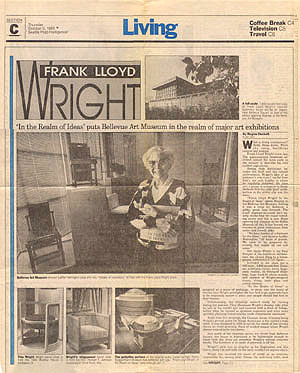 FRANK
LLOYD WRIGHT 'IN THE REALM OF IDEAS' PUTS BELLEVUE ART MUSEUM IN THE
REALM OF MAJOR ART EXHIBITIONS FRANK
LLOYD WRIGHT 'IN THE REALM OF IDEAS' PUTS BELLEVUE ART MUSEUM IN THE
REALM OF MAJOR ART EXHIBITIONS
By
Regina Hackett
Seattle Post-Intelligencer, October 5, 1989
What is living architecture? Betty Boop knew. When
she sang, buildings swayed and danced.
Frank Lloyd Wright knew, too. The quintessential
American architect coined the term early in the century to describe
his own exalted aspirations.
Seeing little distinction between the built and the
natural environment, Wright's idea of an architect's role wasn't too
far from God's, the only builder to whom he regularly deferred. He
once told a group of architects in Santa Barbara that the only good
architecture in the entire city was the trees.
"Frank Lloyd Wright: In the Realm of Ideas" opens
Monday at the Bellevue Art Museum. Getting it was a coup for
Bellevue, a giddy, great leap forward. The small museum-in-a-mall
isn't exactly in-the-loop for major traveling shows and this is one.
Since opening last January at the Dallas Museum of Art, it has
toured the country to great enthusiasm from critics and crowds
alike.
"We have hordes of volunteers for the show," said
director LaMar Harrington, "all kinds of guards. We have to be
prepared for crowds, but maybe no one will come."
Not likely. Wright is the Paul Bunyan of the
American architecture, the closest thing to a home-grown,
architectural cult figure.
Included in the show are a full-scale,
1,800-square-foot Usonian automatic house, seven large-scale models,
15 freehand drawings, huge back-lit photo murals, and clusters of
Wright-designed chairs, china, stain glass and eating utensils.
"In the Realm of Ideas" is designed as a piece of
pedagogy, to drum into the heads of viewers four Wright principles:
the box had to go, materials have to be respected, nature is great
and people should feel free in their houses.
Unfortunately, the drawings weren't ready for
viewing during the preview. They illuminate Wright's dreamy side,
what he saw in his mind's eye and covered with a flush of foliage,
before what he viewed as ignorant engineers and even more ignorant
planning bureaucracies made compromise necessary.
Aside from the drawings, the Usonian house (Usonian
being Wright's private name for things American) is the exhibit's
high point. It was designed in 1955 to satisfy the needs of
low-income clients or, more precisely, those of modest means whom
Wright always wanted to be his clients.
Just south of the museum across the street from
Bellevue Square, the house is fabricated to be lightweight enough to
travel with the show yet resemble Wright's precast concrete blocks.
The furniture in it, made of plywood, is all his.
Wright's style was as singular as his fingerprint,
and this house, slung low and wide on the land, couldn't be anyone
else's.
Wright has received his share of credit as an
inventor, responsible for, among other things, the wall-hung toilet,
steel office furniture, flexible joints for earthquake protection,
indirect lighting and plate glass commercial doors. He's famous for
breaking faith with the box, loving materials both high and low and
wanting to harmonize with, not dominate, the landscape.
Yet he's clearly the unsung hero of roller rinks, to
which his Usonian house seems related. Roller rinks use his kind of
space: low and lean, good for sprints and figure 8's, bad for high
jumps.
His style changed remarkably little over the course
of his long career, except that the exterior angles softened. He was
acutely aware that the new century would call for new styles, and he
wanted his to be a trump.
It was. After five years working as a draftsman in
Louis Sullivan's Chicago office, Wright set out on his own in 1893,
having absorbed crucial lessons from architects such as H.H.
Richardson and Sullivan, who were modernist pioneers advocating
rational principle amid the welter of late 19th century decoration.
His pool of sources was the widest of his generation. It included
Japanese teahouses and summer palaces, Hopi rock dwellings and
Venetian row houses on the water.
One can only imagine the surprise of those who came
upon his early houses. They jut out. They were new and still look
oddly new, a statement of faith in a rosy future of unlimited
resources and scientific breakthroughs.
As Narciso Menocal's excellent catalog essay points
out, Wright was deeply impressed by Edward Bellamy's "Looking
Backward," a novel published in 1888 that imagined American cities
of complete harmony by the year 2000.
Bellamy brought a top hat to socialism. He assumed
that everyone wanted understated elegance and good table manners,
and all people would participate in a collective, white Protestant
male ideal, if they only could.
Wright agreed and wanted to be the white Protestant
male in charge. If he built a house for you, he wanted you to be
free all right, free to live life completely bound by his style. He
chose or designed all the furniture and its placement, the plants,
both indoor and out, the rugs, the lighting and heating system. God
help anyone who even thought of adding any non-Wright touches to
"his" living quarters.
The original scale model for New York's Guggenheim
Museum is the best looking one in the show. Its puttylike, white
surface has softened with age and now looks like Claes Oldenburg
made it.
In person, however, the Guggenheim is absolute
Wright, the most distinctive museum in the world and the least
admired by painters and sculptors. Wright's great rampways coil down
through interior space and make the art in it an afterthought.
Someday there will be regular tours of Frank Lloyd
Wright houses across the country. Till then, seeing this exhibit is
the easiest way to appreciate both the master's range and his
foibles.
|
|
| |
|
|
Related
Reading |
-
|
|
"Usonia Homes, A Cooperative, Inc." Henken,
1947 |
|
"The Natural
House" Wright, 1954, page 196-207 |
|
"The Living City",
Wright 1958, pages 70-1 |
|
"Frank Lloyd
Wright’s Usonian
Houses: The Case for Organic Architecture"
Sergeant, 1976 |
| "Frank
Lloyd Wright, His Life and His Architecture" Twombly,
1979, page 338 |
|
"Frank Lloyd
Wright’s Usonian
Houses:
Designs for Moderate Cost One-Family Homes"
Sergeant, 1984 |
|
"Realization of Usonia:
Frank Lloyd Wright
in Westchester"
Beard, Henken, Henken, 1985 |
|
"Related items from the Usonian
Automatic Traveling Exhibition" 1987 - 1990 |
|
"Wright Seen Anew as an Architect of
Thoughts"
Goldberger, The New York Times, February 7,
1988 |
|
"Usonian
Automatic: Wright's Concrete Masonry" Hurd, Concrete
Construction Magazine, November 1, 1988 (PDF) |
|
"Frank
Lloyd Wright 'In The Realm of Ideas"
Hackett,
Seattle
Post-Intelligencer, October 5, 1989 |
|
"Usonia, Frank Lloyd Wright’s Design for
America"
Rosenbaum, 1997 |
|
"Usonian
Houses", Ehrlich, 2002 |
|
"Frank Lloyd Wright Usonian
Houses GA Traveler 005", Pfeiffer, 2002 |
|
"Westchester Magazine - Best Total
Concept. Usonia."
Epstein, October 2004, pages 66-67 |
|
"Frank Lloyd
Wright, Complete Works 1943-1959", Pfeiffer; Gossel,
2009, page 216-217. |
| |
| |
| |
|
|
|
|
|
|
|
|
|
|
|
|



"Modern Architecture, Being the Kahn Lectures for 1930", Wright, 1931. Of interest is the illustration that proceeds Chapter 5. The illustration is entitled "Bock Ateliers. Concrete. Slab Roof. Stone Washes and Water Table. Windows Wrapping Corners to Express Interior Space. 1902." Bock met Wright in 1892 while working for Adler & Sullivan. Bock’s first commission from Wright was for the Frieze on the third floor of the Heller Home (1896 - S.038). He also worked on other Wright projects including the Stork (1898) and Boulder (1898) for Wright’s own Studio, the Dana Residence (1902 - S.072), Larkin Building (1903 - S.093), Scoville Park Fountain (1903 - S.094), Unity Temple (1904 - S.096), Martin (1904 - S.100), City National Bank (1909 - S.155), and Midway Gardens (1913 - S.180) just to name a few. In 1902 Wright to design a home and studio for Bock. It was designed in concrete. This was two years before the concrete Unity Temple, twenty-one years before Wright’s first concrete block home, the Millard Residence (1923 - S.214), and 49 years before the first Usonian Automatic, the Adelman Residence (1951 - S.344). Wright included the concrete "Bock Ateliers" in his 1910 Wasmuth Portfolio Plate LXII. Although the 1902 window casements were most likely designed in wood, Wright slightly modified the 1931 window design to include mitered glass corners, a precursor to Wright’s 1951 Usonian Automatic Homes.
